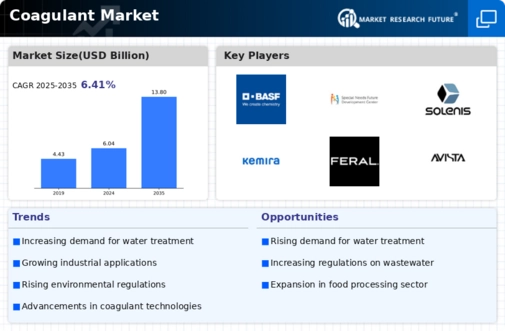Market Analysis
In-depth Analysis of Coagulant Market Industry Landscape
The market dynamics of the coagulant industry are influenced by various factors that shape its growth, trends, and competitiveness. Coagulants play a crucial role in water treatment processes, aiding in the removal of impurities and suspended solids from wastewater, drinking water, and industrial effluents. Firstly, regulatory requirements drive market dynamics significantly. Stringent environmental regulations governing water quality and discharge standards compel industries to invest in effective coagulation solutions to meet compliance requirements. Compliance with regulations ensures not only environmental protection but also public health safety, driving the demand for coagulants in various sectors.
Technological advancements also play a pivotal role in shaping the market dynamics of coagulants. Innovations in coagulant formulations, manufacturing processes, and application methods lead to the development of more efficient, cost-effective, and environmentally friendly products. Manufacturers strive to introduce coagulants with improved performance characteristics, such as higher efficacy, lower dosage requirements, and reduced environmental impact, catering to the evolving needs of end-users across different industries. The growing population and rapid urbanization across the globe will increase the demand for water, and thus is likely to generate a large quantity of wastewater, which is expected to create growth opportunities for the players operating in the global coagulant market during the forecast period.
Moreover, the competitive landscape significantly influences market dynamics. Established players in the coagulant industry compete for market share through strategies such as product differentiation, pricing, and marketing initiatives. Additionally, partnerships and collaborations between coagulant manufacturers, water treatment companies, and research institutions contribute to market expansion and innovation. These collaborations enable companies to leverage their combined expertise in research, development, and distribution, driving growth and competitiveness in the market.
Global economic conditions and geopolitical factors also impact market dynamics. Economic growth, population expansion, and urbanization drive the demand for clean water, increasing the need for coagulants in water treatment applications. Moreover, geopolitical tensions, trade policies, and supply chain disruptions can create uncertainties and challenges for industry players, affecting production, distribution, and pricing dynamics of coagulants.
Consumer awareness and education initiatives play a vital role in shaping market dynamics. Informative campaigns highlighting the importance of effective water treatment and the role of coagulants in ensuring clean and safe water encourage adoption among consumers and industries. Moreover, regulatory agencies and industry associations provide guidelines and standards for coagulant usage, promoting best practices and ensuring product quality and efficacy.
Emerging trends and market opportunities contribute to the dynamic nature of the coagulant market. The increasing focus on sustainable development and water conservation drives the demand for eco-friendly coagulation solutions, prompting manufacturers to explore alternative raw materials and greener production processes. Additionally, advancements in water treatment technologies, such as membrane filtration and advanced oxidation processes, create new opportunities for coagulant applications and innovation.













Leave a Comment